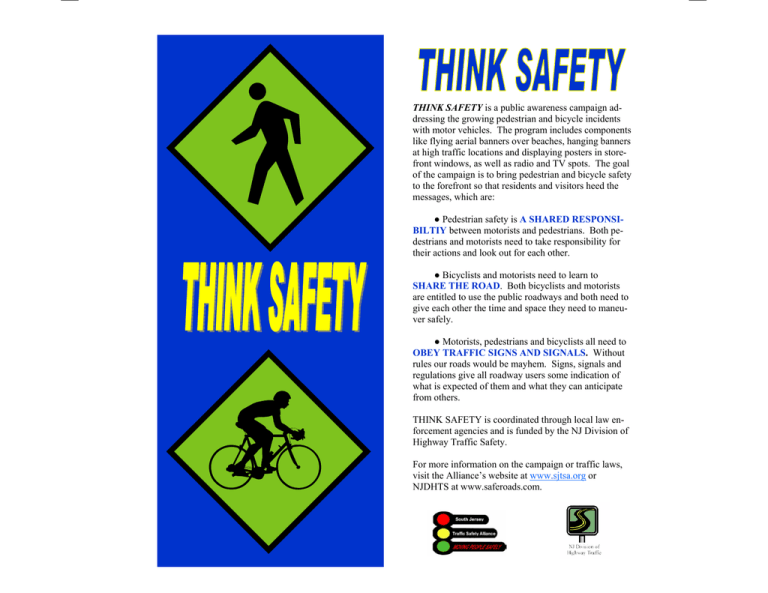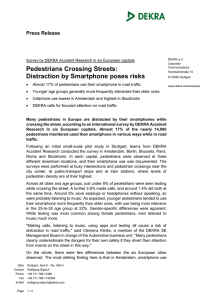THINK SAFETY is a public awareness campaign ad
Anuncio

THINK SAFETY is a public awareness campaign addressing the growing pedestrian and bicycle incidents with motor vehicles. The program includes components like flying aerial banners over beaches, hanging banners at high traffic locations and displaying posters in storefront windows, as well as radio and TV spots. The goal of the campaign is to bring pedestrian and bicycle safety to the forefront so that residents and visitors heed the messages, which are: ● Pedestrian safety is A SHARED RESPONSIBILTIY between motorists and pedestrians. Both pedestrians and motorists need to take responsibility for their actions and look out for each other. ● Bicyclists and motorists need to learn to SHARE THE ROAD. Both bicyclists and motorists are entitled to use the public roadways and both need to give each other the time and space they need to maneuver safely. ● Motorists, pedestrians and bicyclists all need to OBEY TRAFFIC SIGNS AND SIGNALS. Without rules our roads would be mayhem. Signs, signals and regulations give all roadway users some indication of what is expected of them and what they can anticipate from others. THINK SAFETY is coordinated through local law enforcement agencies and is funded by the NJ Division of Highway Traffic Safety. For more information on the campaign or traffic laws, visit the Alliance’s website at www.sjtsa.org or NJDHTS at www.saferoads.com. Bicycle Safety SHARE THE ROAD Pedestrian Safety A SHARED RESPONSIBILITY In New Jersey, bicyclists have the same rights and responsibilities as a motor vehicle. Therefore, motorists and bicyclists must share the road. In New Jersey, motorists are required to yield to pedestrians in a crosswalk. However, this does not mean pedestrians can walk BICYCLISTS SHOULD: right into the crosswalk and neglect their responsibility to look both ways and take appropriate safety measures. ● Wear a helmet – NJ Law requires anyone under the age of 17 to wear a properly fitted and fastened helmet while cycling, roller skating, in-line skating and skateboarding. PEDESTRAINS SHOULD: • Use Crosswalks at intersections – its where motorists expect to see you ● Ride on the Right ● Obey Traffic Signs and Signals • Use hand signals to convey intentions • Obey pedestrians signals when available • Make eye contact with drivers • Continue to look for motor vehicles while crossing the street • Carry identification • ICE - Program your cell phone with an In Case of Emergency phone number saved as ICE • BE SAFE BE SEEN – where bright colored or reflective clothing. Motorists can’t avoid you if they can’t see you. Left Turn Right Turn Stop • Use a horn or bell – NJ Law requires that all bikes be equipped with a horn or bell to alert drivers and pedestrians of your presence. • Use lights at night - NJ Law requires all bikes to be equipped with a white light on the front and a red light on the rear when riding at night. MOTORISTS SHOULD: ● Carry Identification and use ICE (see pedestrian safety) • Yield to pedestrians in crosswalks – 2 point violation MOTORIST SHOULD: • Look for pedestrians when approaching an intersection • Reduce speed when approaching an intersection • Stop behind painted crosswalks and stop line • Obey traffic signs and signals • • • • Recognize bicyclists as authorized roadway users Give bicyclists plenty of room Yield to bicyclists NEVER blow your horn – you may startle them and cause them to ride into traffic Seguridad Peatonal UNA RESPONSABILIDAD COMPARTIDA En New Jersey se exige que los conductores cedan el paso a los peatones en los cruces peatonales. Sin embargo, esto no significa que estos últimos puedan caminar por los cruces peatonales desentendidos de su responsabilidad de mirar en ambas direcciones y de tomar las medidas de seguridad apropiadas. Los peatones deben: ● Usar los cruces peatonales en las i ntersecciones, pues es ahí donde los conductores esperan encontrarlos • Obedecer las señales para peatones, cuando las haya • Ver a los ojos a los conductores • Continuar prestando atención a los vehículos al cruzar la calle • Tener identificación • PROTEGERSE: HACERSE VER – use ropa de colores brillantes o reflectante Los conductores deben: • Ceder el paso a los peatones en los cruces peatonales – infracción de 2 puntos • Seguridad para ciclistas COMPARTA EL CAMINO En New Jersey, los ciclistas tienen los mismos derechos y responsabilidades que los conductores de vehículos. Los ciclistas deben: • • • • • • Usar casco – la ley de NJ exige que toda persona menor de 17 años use un casco, ajustado y abrochado debidamente, al andar en bicicleta, patines, patines en línea y patineta. Andar a su derecha Obedecer los letreros y las señales viales Usar la mano para hacer señas que comuniquen sus intenciones Usar un claxon o una campana – la ley de NJ exige que todas las bicicletas estén equipadas con un claxon o una campana para alertar de su presencia a los conductores y peatones Usar luces de noche - la ley de NJ exige que todas las bicicletas que se usen de noche estén equipadas con una luz blanca en el frente y una luz roja en la parte trasera Los conductores deben: • Considerar a los ciclistas como usuarios autorizados de los caminos Al aproximarse a intersecciones, verificar si hay peatones • Dar a los ciclistas bastante espacio • Al aproximarse a intersecciones, reducir la velocidad • Ceder el paso a los ciclistas • Detengase antes de los cruces peatonales y las lineas limite pintadas • • Obedecer los letreros y las señales viales NUNCA hacer sonar el claxon, pues esto podría causar un sobresalto y hacer que el ciclista se desviara hacia el tráfico
